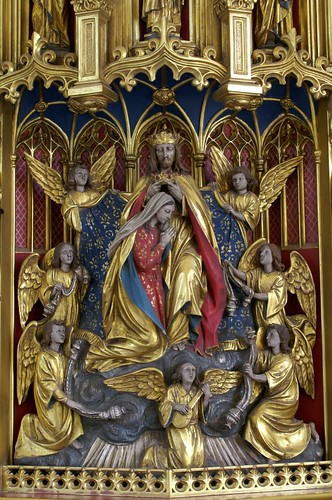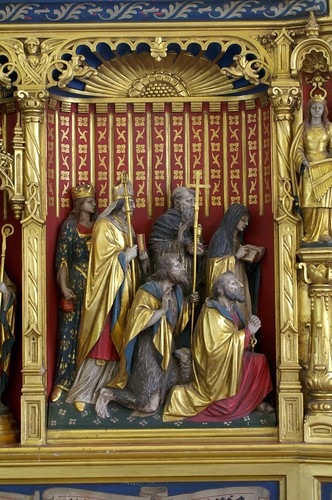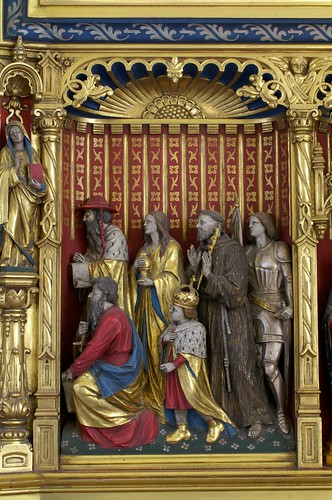North Cerney, Gloucestershire - part 1
If I was a country parson living in, dare I say it, the good-old-days of the Church of England, when there was one priest per parish. The one parish I would love to serve would be North Cerney in the Cotswolds near Cirencester. In my mind the church in North Cerney is near-perfection. A glorious medieval building, of Norman origins, with late medieval ceiling and stained glass and sublime modern furnishings.

The church was refurnished almost entirely between 1913 and 1967, through the vision and munificence of W. I. Croome (1891-1967) who lived in the neighbouring Cerney House. Croome, who was a founding member of the Council for the Care of Churches, was a protege of F. C. Eeles. Like Eeles he was an officienado of the 'English Use', the liturgical and visual ethos commonly associated with the Warham Guild and Percy Dearmer. So naturally the furnishing of North Cerney follows, in principle, the English Use ethos. For his architect Croome chose a very inventive and able man, another 'F C', F.C. Eden. Eden had a pupil of G F Bodley and in his work you can see the influence both of Bodley and also of his contemporary Sir Ninian Comper. Over the course of a number of posts I'm going to consider some of the individual elements of Eden's work at North Cerney, starting today with the high altar.
The chancel at North Cerney is sparsely furnished space. That is intentional, as it draws the eye immediately to the glorious gilded reredos that Eden designed in 1924 - the focus of the church. The subject of the reredos, which is a triptych of three relief panels, is All Saints, the dedication of the church. The taller central panel of the reredos represents the moment of Our Lady's coronation as Queen of Heaven and Queen of the Saints. She is surrounded by lively figures of censing angels. The panel is reminiscent of the north European limewood altarpieces of the late Gothic period.


The two side panels incorporate representative groups of saints, kneeling or standing in adoration of the central scene. You can identify the saints yourself!

In design terms the frame of the reredos presents a 'unity by inclusion' style of architecture, in the main it uses renaissance motifs, based on a classical vocabulary. The central panel is backed with blank Gothic arcading and is surmounted by a a triplet of ogee arches, set between pinnacles and pendants. The unified colouring and rich gilding of the reredos pulls the whole thing together. This unity by inclusion approach works extremely well in this context. Before Eden set foot in the place the church already exhibited a ecletic array of different styles, Norman doors, early Gothic tower, Perpendicular transepts, seventeenth century classical tablets. Somehow the reredos gives a sense of visual cohesion to this eclecticism.
I should mention that during Lent the altar and reredos are covered by handpainted Lenten array in unbleached linen. The Lenten array is almost as glorious as the altarpiece itself.

Anyway more tomorrow.

The church was refurnished almost entirely between 1913 and 1967, through the vision and munificence of W. I. Croome (1891-1967) who lived in the neighbouring Cerney House. Croome, who was a founding member of the Council for the Care of Churches, was a protege of F. C. Eeles. Like Eeles he was an officienado of the 'English Use', the liturgical and visual ethos commonly associated with the Warham Guild and Percy Dearmer. So naturally the furnishing of North Cerney follows, in principle, the English Use ethos. For his architect Croome chose a very inventive and able man, another 'F C', F.C. Eden. Eden had a pupil of G F Bodley and in his work you can see the influence both of Bodley and also of his contemporary Sir Ninian Comper. Over the course of a number of posts I'm going to consider some of the individual elements of Eden's work at North Cerney, starting today with the high altar.
The chancel at North Cerney is sparsely furnished space. That is intentional, as it draws the eye immediately to the glorious gilded reredos that Eden designed in 1924 - the focus of the church. The subject of the reredos, which is a triptych of three relief panels, is All Saints, the dedication of the church. The taller central panel of the reredos represents the moment of Our Lady's coronation as Queen of Heaven and Queen of the Saints. She is surrounded by lively figures of censing angels. The panel is reminiscent of the north European limewood altarpieces of the late Gothic period.


The two side panels incorporate representative groups of saints, kneeling or standing in adoration of the central scene. You can identify the saints yourself!

In design terms the frame of the reredos presents a 'unity by inclusion' style of architecture, in the main it uses renaissance motifs, based on a classical vocabulary. The central panel is backed with blank Gothic arcading and is surmounted by a a triplet of ogee arches, set between pinnacles and pendants. The unified colouring and rich gilding of the reredos pulls the whole thing together. This unity by inclusion approach works extremely well in this context. Before Eden set foot in the place the church already exhibited a ecletic array of different styles, Norman doors, early Gothic tower, Perpendicular transepts, seventeenth century classical tablets. Somehow the reredos gives a sense of visual cohesion to this eclecticism.
I should mention that during Lent the altar and reredos are covered by handpainted Lenten array in unbleached linen. The Lenten array is almost as glorious as the altarpiece itself.

Anyway more tomorrow.
Comments
Croome formed a friendship with F. C. Eden and Sir Walter Tapper and together they travelled every spring for some years in Italy. It was in Florence that he, with their advice, bought the continental furniture and statuary (notably the corpus on the rood) for the church. Comper was brought in to design the stone altar in order to get the medieval proportions right, but otherwise had nothing more to do with the church. But the Sisters of Bethany executed the needlework and H. A. Bernard Smith and his assistants the painted decoration, while the mason's yard of W. D. Gough (also trained by Comper) did much of the carving. All of this I was told by Croome when he showed me the church.
It was Croome's eclectic taste that broadened Eeles's narrow English preferences and opened the way to moderate Renaisssance influence in schemes of decoration approved later by the Council for the Care of Churches. This was not achieved without a sruggle with Eeles's reluctance to follow that path. Eden most fully represented Croome's architectural preferences, reinforced by Tapper's equally eclectic taste. There was no influence or participation in the work of the Warham Guild which, Croome believed, represented the best that could be done on a commercial basis within the means of the average parish, but little more.
The entire context and social interaction of that period and school of church furnishing was far subtler and complex than it seems on the suface. North Cerney is less doctrinaire than the Dearmer-Eeles line of succession, and is the better for being so. As for Dearmer, Croome believed he had 'gone off rhe rails' (his words) in his later life and he had no sypathy for his socialist politics.